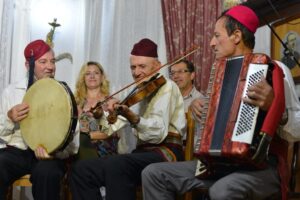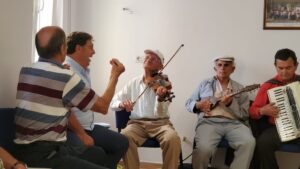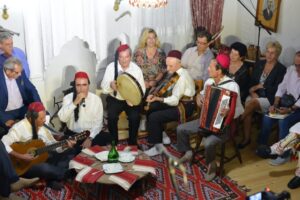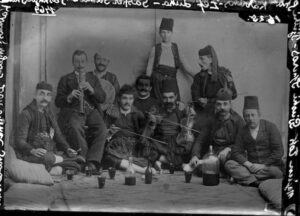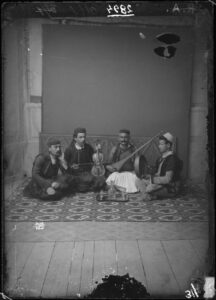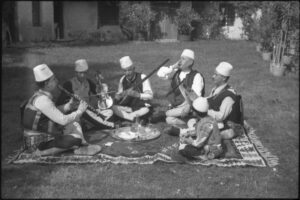The Shkodra’s Aheng songs, were widespread as a musical composition from the end of the 18th century until the 40s of the 20th century. Aheng songs did not emerge from the traditional local style. The term Shkodran means that owing to the influence of oriental music, aheng song featured several distinguishing peculiarities from the other genres. This type of song was born as such due to the ways in which the melody or oriental song lends itself to the Shkodra environment, how it was further transformed and composed by local ahengxhi-s (aheng singers), occasionally adapting to this genre the melodic and rhythmic elements as well as the stylistics of the local musical tradition.
These songs maintained their relevance in weddings, family celebrations, and entertainment, in the characteristic Shkodra houses, in yards and gardens, under the mulberry tree shade, and later in concert scenes, radio, and TV screens, leading for years an independent artistic life. The instruments played by aheng players are: saze, qemane (violin), dajre (tambourine), etc.
The saze is an oriental, chordophone, and ten-string instrument. The most important part is setting the scale at its neck/sap. The first part of the sounding board produces some microtones while the rest produces semitones. The Shkodran Aheng, it played the leading role in the melody. This instrument has been used in the aheng group for about 150 years. It remained an untempered instrument solely in Shkodra.
The introduction of the Turkish makam system (musical scale) was influential in the evolution of this song. Its distinctive features have made the aheng song so unique all over Albania. The earliest group we have known to this day dates back as far as the 18th century by Mehmet Shllaku.
1. Pranvera filloi me ardhë.
2. Iptida për t’paren herë.
3. O bylbyl, o more i mjerë.
4. Dashnuer t’u bana. (Fjalët dhe muzika Hazan Preza)
5. Të gëzojmë se erdh pranvera. (Fjalët dhe muzika Hazan Preza)
6. Dalin vajzat prej mejtepit. (Fjalët dhe muzika Hazan Preza)
7. Shkoj e vi flutrim si zogu. (Fjalët dhe muzika Hazan Preza)
8. Moj e vogël si floriri. (Fjalët dhe muzika Alush Beqari)
9. Oh! N’atë fushë t’mejdanit.
10. Vaj si kenka ba dyrnjaja. (Fjalët dhe muzika Ndrekë Vogli-Naraçi)
11. Metelikun ta kam fal.
12. Hylli qi del n’sabah.
13. Moj fëllanxë qi rrin në kafaz.
14. Karajfilat qi ka Shkodra.
15. Iptida du me fillue. (Fjalët dhe muzika Palokë Kurti)
16. Kur fillon drita me dalë.
17. Balli yt prenvera. (Fjalët dhe muzika Nush Pali)
18. Nji tubë drandofille po të çoj.
19. Kanga e Gjyles.
20. Karajfil në kodër. (Fjalët dhe muzika D. Zef Shestani)
21. Sa me t’shpejtë ma vune kamben. (Fjalët dhe muzika Ejell Çeka)
22. Karajfili në saksi.
23. Karajfil të zgodha.
24. Në pranverë që kena hi. (Fjalët Kolë Gurashi, muzika Nush Pali)
25. M’i gëzofsh pesëmbëdhetë pranverat.
26. Moj e mirë synin larushë.
27. Pse ti lule rri mshehun.
28. Çile atë zemër plot kujtime. (Fjalët dhe muzika Paulin Pali)
29. Drandofille me shumë erë.
30. Ç’u këputa unë e mjera.
31. Karajfili kuq si gjaku.
32. Jelino. (Fjalët dhe muzika Ramadan Sokoli)
33. Vashës. (Fjalët dhe muzika Frano Jakova)
34. K’ndon bylbyli poshtë te zalli. (Fjalët dhe muzika Karlo Pali)
35. K’ndo bylbyl me t’madhin za. (Fjalët dhe muzika Karlo Pali)
36. Bylbyli në pranverë.
37. Tash ka çilë pranvera.
38. Dielli sa të ketë prendue. (Fjalët dhe muzika Paulin Pali)
39. Mori drandofillja e vogël.
40. Moj e bukur tash sa vjet.
41. Çka kanë sytë e mi qi kjajnë.
42. Ma ke gishtin për unazë. (Fjalët Tefë Krroqi, muzika Tonin Rrota)
43. Tash sa dit e mot.
44. Jargavan me bojë për mall. (Fjalët Simon Çurçija, muzika Ndrekë Vogli-Naraçi)
45. Ti moj Shkodër, Shkodra jonë. (Fjalët dhe muzika Gasper Zadeja)
46. Syn’ e zi si mereqepi.
47. As aman moj Gjyla e Rremit.
48. Jar te due, mori të due.
49. Marshall bukurisë sate. (Fjalët dhe muzika Palokë Kurti)
50. Për mue paska kenë kismet. (Fjalët dhe muzika Palokë Kurti)
51. Kenka nuri i bukurisë. (Fjalët dhe muzika Bejto Halili)
52. Hajde Gjyle.
53. Po ti çka i ke thanë dikujt.
54. Hije t’bajshin ty qerpikët.
55. Dola në penxhere.
56. Moj fellanxë e malit.
57. Nji lule qi mka cilë tash.
58. Bishtalecat palë-palë.
59. Syni yt porsi ullini.
60. Bakushes.
61. S’ka ma t’bukur se pranvera. (Fjalët dhe muzika Rud Gurashi)
62. Me pak bejta due me t’thanë.
63. Kur t’i shof dy ytë e shkruem.
64. Kur më del në derë.
65. Kur fillon drita me dalë.
66. Si t’kam dashtë unë ty.
67. Njata sytë e zezë, o të zezë.
68. Pranverë, pranverë. (Fjalët dhe muzika Namik Mithi)
69. Pranvera me dalë ka fillue. (Fjalët dhe muzika Nush Pali)
70. N’Shkodër tonë ka ra nji dritë. (Fjalët dhe muzika Palokë Kurti)
71. Krisi topi. (Fjalët dhe muzika Hysen Dobraçi)
72. Kur më flet me gojë moj Gjyle.
73. Kanga e Oso Kukës. (Fjalët dhe muzika Zenel Maha)
74. Kanga e Ali Pashë Tepelenës.
75. Ti je krejt si nji ganxhe. (Fjalët dhe muzika Paulin Pali)
76. Në gjergjef vasha tue qendisë. (Fjalët dhe muzika Ramadan Sokoli)
77. Sillet moti për së mbarit. (Fjalët dhe muzika Marku i Kranjanes)
78. Kanga e Dedë Gjo’Lulit.
79. Midis t’ballit m’kenji pikë.
80. Sa e kandshme vjollcë ti je. (Fjalët dhe muzika Paulin Pali)
81. Në nji kopsht t’bukur unë e mblodha. (Fjalët dhe muzika Paulin Pali)
82. As aman moj lulja e Allit.
83. Po ta marr kangen me saze. (Fjalët dhe muzika Mani Zylkos )
84. Ani ma ven doren permbi dorë.
85. Hajde mori vashë se na erdhi vera.
86. Ala emnin s’ta kam xanë. (Fjalët dhe muzika Ndrekë Vogli-Naraçi)
87. Çka ke vashë qi m’je habitë.
88. Çou moj vashë.
89. Karajfili kuq si gjaku. (Fjalët dhe muzika Sait Hoxha)
90. Pranverë e bukur.
91. Mori vjollcë qi çilë n’pranverë.
92. Kur të pashë moj lule. (Fjalët dhe muzika Paulin Pali)
93. Shumë pranvera po kalojmë. (Fjalët dhe muzika Karlo Pali)
94. Si dukat i vogël je.
95. Si t’kam dashtë unë ty.
96. Me dymbëdhjetë mekame qi janë.
97. T’dilen nade n’sabahile. (Muzika Kasem Xhuri)
98. Jare, iptida due me fillue. (Fjalët Jonuz Shiroka, muzika Gjok Kraja)
99. Me dy tri pikali në faqe.
100. Hajde verë e bardha verë.
101. Ganxhet tuja me shumë erë.
102. Të kam dashtë dhe prap të due. (Fjalët dhe muzika Karlo Pali)
103. Tri vjet që u deshtëm bashkë. (Fjalët dhe muzika Tofik Duka)
104. Moj flokëkuqe. (Fjalët dhe muzika Kolë Gurashi)
105. Pse më len në kët zalldan.
106. Venma dorën përmbi dorë.
107. S’parit kur të pashë.
108. E para pemë piqet qershia.
109. O moj bukuroshe.
110. Kur më shkon si zog n’hava. (Fjalët dhe muzika Kolë Vjerdha)
111. Gjylvatani.
112. Në kohë t’mbramjes në pranverë. (Fjalët dhe muzika Karlo Pali)
113. Karajfili e drandofilli.
114. Këpucët me meste.
115. Bylbylit.
116. Në zaman t’njasaj furi. (Fjalët Hila i Files, muzika Palokë Kurti)
117. Turtulleshë. (Fjalët Qemal Draçini, muzika Ramadan Sokoli)
118. Për ty vashë.
119. Ti në kumbull, unë në kumbull.
120. Edhe baba po m’bërtet.
121. Ishin mbledhë lulet në bahçe.
122. Kur më rrin karshi-karshi.
123. Nji kllef me ar ta çova. (Fjalët dhe muzika Palokë Kurti)
124. Nji vajzë t’mirë qi ka kojshia.
125. I kam hypë vaporrit.
126. Drandofilles së bukur. (Fjalët dhe muzika Paulin Pali)
127. Vjollcës.
128. Kush ma i pari bani.
129. Drandofille me erë plot.
130. Edhe nji herë due me kja hallin. (Fjalët dhe muzika Ndrekë Vogli-Naraçi)
131. Lules’parit vjollca nisi.
132. Mori vjollcë qi çilë n’panverë.
133. Nën nji mal e nën nji rranxë.
134. Legjenda e Rozafatit. (Fjalët dhe muzika Lan Kalaja)
135. Kënga e Halitit.
136. Njatje poshtë te mullini.
137. Po të pres te dega e fikut.
138. Ani n’atë kodër.
139. Zanushës. (Fjalët dhe muzika Ramadan Sokoli)
140. Bash zamanit t’djelmenisë.
141. Marshalla moj bukuri.
142. Shkova n’çesme me mbushë ujë.
143. Ja na erdhi sot pranvera. (Fjalët dhe muzika Paulin Pali)
144. K’ndojnë bylbylat kah pranvera.
145. Shumë lulet na i qet pranvera. (Fjalët dhe muzika Paulin Pali)
146. U thasha si thahet fiku.
147. Porsi flutur.
148. Gjylistane moj gjylistane.
149. Kah mendoj se erdh pranvera.
150. Oh pranverë sa jam tue prit. (Fjalët dhe muzika Namik Mithi)
151. Freski pranvere. (Fjalët dhe muzika Paulin Pali)
152. Unë e mjera kam pasë drashtë.
Close

